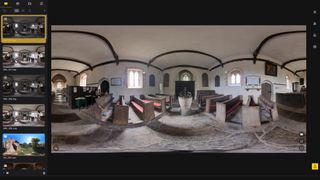The Insta360 X3 has a familiar lozenge, or “candy bar” shape that makes it really easy to fit into a shirt or a trouser pocket. It uses back-to-back 180°+ fisheye lenses and stitches their output together in-camera to produce a seamless 360° spherical view of everything around the camera. It can capture 5.7K spherical video and huge 72MP still images.
Insta360 sees this as today’s equivalent of the point and shoot camera – except with this one you can shoot first and point later, reframing your 360 video or stills into regular ‘flat’ video and photos that show whichever part of the scene you want.
The X3 is the latest version of Insta360’s pocket-sized ONE X range, though this time it’s dropped the ‘ONE’ from the name. Insta360 also makes the modular ONE R and ONE RS cameras using similar technology but a different form factor, plus a range of more advanced pro 360 VR cameras in a different price bracket.
So where does it fit in to the world of video. First, it's one of the best 360 cameras you can get right now, but a 360 camera like this is also an intriguing option when choosing the best camera for video generally. Its 4K Single Lens mode adds versatility, and makes it an interesting alternative to the best action cameras, and it's arguably one of the best cameras for vlogging if you like a much more close up 'immersive' filming style and can do without interchangeable lenses.
Specifications
Aperture: f/1.9
35mm Equivalent Focal Length: 6.7mm
Photo Resolution: 72MP (11968x5984), 18MP (5952x2976)
Video Resolution: 5.7K: 5760x2880@30/25/24fps, 4K: 3840x1920@60/30fps
Single-Lens Mode: 4K: 3840x2160@30/25/24fps, 3.6K: 3584x2016@60/50/30/25/24fps, 2.7K: 2720x1530@60/50/30/25/24fps, 1080p: 1920x1088@60/50/30/25/24fps”
Photo Format: insp (can be exported via mobile app or desktop Studio), DNG RAW (PureShot photos must be edited on desktop)
Video Format: Single Lens: mp4, 360: insv
Storage: MicroSD UHS-I V30 speed class, exFAT format SD cards with a max storage of 1TB are recommended.
Battery Capacity: 1800mAh
Run Time: 81min (Tested in lab environment in 5.7K@30fps mode)
Dimensions (W x H x D): 114.0x46.0x33.1mm
Weight: 180g
Key features


In many respects the Insta360 X3 is similar to the ONE X2 and the original ONE X before it, but there have been some significant advances, both in the capture technology and the shooting modes available, not to mention improvements in the design.
First, the X3 now has larger 1/2-inch sensors. These are still smaller than the 1-inch sensors in the Insta360 ONE RS 1-inch 360 camera, but that’s a larger and more expensive model. The new 1/2-inch sensors in the X3 are a significant step up from those in the ONE X2 before it.
The maximum video resolution stays the same, but the X3 can now shoot spherical still images at 72 megapixels. It also boasts a new 4K Single Lens mode, where it effectively turns into a GoPro style action camera – and there’s a 2.7K ultra-wide 170° degree view too. As well as 5.7K spherical video and 4K action cam footage, the X3 can also capture 8K timelapses.
If you’re an influencer mostly interested in filming yourself, there’s a new Me mode that automatically keeps you center frame, without the need for any editing later, and a new Active HDR mode aims to bring out deep shadow detail that might otherwise be lost.
The X3 has had some physical upgrades too. The most obvious is the larger 2.9-inch touchscreen display, and if you think the memory card and battery door is harder to open than normal, that’s because the camera has now been waterproofed to a depth of 10m/33ft.
Battery life has been improved with a new 1800mAh lithium ion battery, and Insta360 claims a runtime of 81 minutes (shooting 5.7K video at 30p).
Build and handling


It sounds as if these changes should make the Insta360 X3 a much bigger camera, but while it has gained a little bulk, it’s not much, and it’s still perfectly pocketable.
The bigger screen does make a big difference to the handling, though. It’s still quite small, but Insta360 has kept the icons pretty big and the swipes and sections pretty straightforward, so there’s less need to use your phone to control it, which is good because juggling a camera in one hand and a phone in the other is not ideal.
We didn’t have the nerve to test out Insta360’s trademark Bullet Time mode, where you swing the camera around your head for a Matrix-style sequence, but we did use the invisible selfie stick and also the optional 3m extended selfie stick Insta360 sent along for evaluation. The regular invisible selfie stick is indeed invisible, being cloned out of sight during the stitching process. However, the hand holding it is not, so you might want o research some different grips so that your hand does’t look oddly contorted.
The 3m extended stick is quite something, though the thinner top sections do get a little wobbly at full extension. It does allow you, however, to get some quite convincing ‘drone’ shots from elevated positions.
The 3m waterproofing is welcome, though it does mean the USB and battery and memory card doors are little stiff to open.
Performance
Insta360’s FlowState stabilization is pretty awesome. You can just be walking along, dropping the camera to ground level, poking it through archways, raising it above head height and it just smooths everything out beautifully. It doesn’t matter if the camera is tilted, twisted or even horizontal – the 6-axis gyro keeps everything flat and level.
The image quality is great too. You do sometimes get a 'stabilization shimmer' or a slightly woolly join, but not that often. You also have to remember that 5.7K doesn’t go far when it’s spread over the inside of a sphere. Video (and stills) look crystal clear when viewed as immersive 3D content in a suitable player, but if you use the software’s clever reframing tools for subject tracking or panning, you will only be using a part of that captured image, so exported ‘flat’ video is only 1920 x 1080 resolution.
But then if you want a conventional action-style video, you can always use the X3’s new 4K Single Lens mode, where it’s turned into a very effective 4K action camera.







The Active HDR mode is a little less convincing. In our tests it raised shadow brightness just a little too far and produced a somewhat flat and oversaturated look – and as the camera viewpoint changed, so from time to time did the HDR adaptation, leading to some quite rapid tonal shifts in skies, for example.
Overall, though, the Insta360 X3 does so much, and generally to such a high standard, that you can forgive it the odd glitch. 360 imaging is an amazing but also confusing medium to work in, but the X3 makes it the easiest and most fun it’s ever been and Insta360’s app-based Shot Lab really shows what it – and you – can create.
Verdict

The Insta360 X3 is the ultimate immersive video camera. It very literally captures everything around you, enabling you to create 3D VR content easily, or use its software based reframing tools to edit your scenes as regular ‘flat’ video, where you can track subjects, create panning shots and basically point the camera where you like AFTER you’ve shot your video.
Having said that, and despite all its great new features, the Insta360 X3 does feel like an evolution of the concept rather than a giant leap forward. For us, that’s only likely to come with 12K capture and the ability to reframe and export 4K movies. For now, though, the X3 is still just about the best, friendliest and most exciting 360 camera on the market.
Read more:
• Best 360 cameras
• Best cameras for video
• Best cameras for vlogging
• Best action cameras

